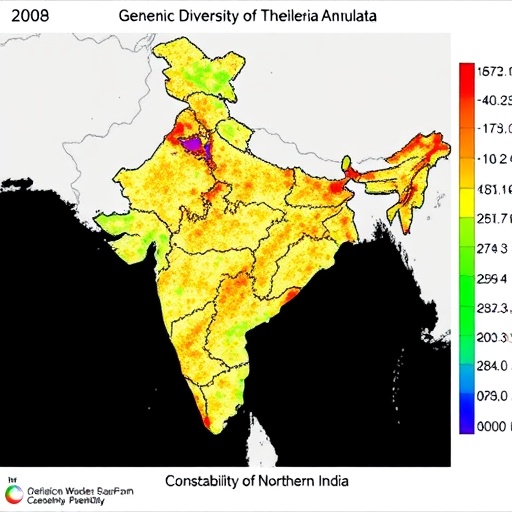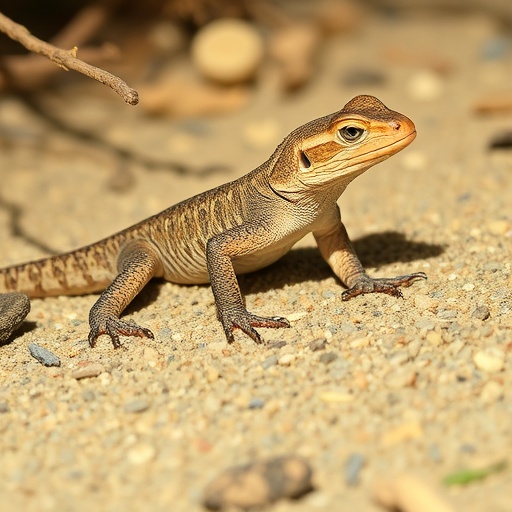
In the rapidly evolving field of parasitology, understanding the genetic diversity of pathogens plays a critical role in developing effective control strategies and vaccines. A recent study published in Acta Parasitologica has provided groundbreaking insights into the genetic makeup of Theileria annulata, a tick-borne protozoan parasite responsible for tropical theileriosis, a disease that severely impacts cattle health and productivity in northern India. This research highlights the complex genetic variations present in calf isolates of Theileria annulata by focusing on the mitochondrial cytochrome b (Cyt B) gene, a crucial marker for tracing evolutionary relationships and genetic heterogeneity within parasite populations.
Theileriosis is a devastating veterinary disease caused by the apicomplexan parasite Theileria annulata, transmitted by Hyalomma ticks. It causes severe clinical symptoms in bovines, including high fever, lymphadenopathy, anemia, and in many cases, mortality. The economic losses associated with this disease, particularly in regions reliant on cattle farming, necessitate an in-depth understanding of the parasite’s genetics to formulate improved diagnostics, therapeutics, and management strategies. This study pioneers the examination of genetic diversity using the Cyt B gene in calf isolates—young animals often more susceptible to infection—thus shedding light on an understudied demographic critical to controlling the parasite’s transmission cycle.
Mitochondrial genes have long been valued in parasitology and evolutionary biology due to their high mutation rates, maternal inheritance, and relative conservation across species. The Cyt B gene, encoding a critical component of the respiratory chain, offers an ideal target for investigating genetic diversity on the molecular level. By assessing the Cyt B sequences from multiple Theileria annulata isolates collected from northern Indian calves, researchers have uncovered a rich tapestry of genetic variants. This variability suggests not only multiple introductions or evolutionary lineages within the region but also the potential for adaptive evolution in response to host immune pressures or environmental factors.
The methods employed in this study reflect a rigorous approach combining molecular biology, bioinformatics, and phylogenetics. After meticulous sampling and DNA extraction from infected animals, the Cyt B gene was amplified and sequenced. Advanced computational techniques then facilitated alignment and phylogenetic tree construction, enabling a comprehensive comparison between isolates. These methodologies not only validate the findings but also establish a framework for future research targeting other genes or parasite populations, enhancing our collective ability to monitor disease dynamics on a genetic level.
One of the most striking revelations from this research is the presence of multiple distinct haplotypes among the calf isolates, indicative of wide-ranging genetic diversity within a relatively confined geographic area. Such diversity has profound implications for vaccine design and the development of molecular diagnostics. Vaccines targeting conserved antigens may face challenges if the parasite exhibits significant antigenic variation due to genetic divergence. Furthermore, molecular diagnostics relying on gene targets with high genetic variability risk false negatives or reduced sensitivity. This study underscores the necessity of incorporating genetic diversity data into the pipeline of diagnostic and vaccine development.
Beyond immediate practical applications, these findings also contribute to the broader understanding of parasite evolution and epidemiology. The high degree of genetic diversity detected aligns with the complex life cycle of Theileria annulata, which alternates between tick vectors and vertebrate hosts, exposing it to varying selective pressures. Moreover, such diversity may facilitate rapid adaptation to environmental changes, host immune evasion, or drug pressures. The study opens avenues for longitudinal research to monitor how these genetic profiles shift over time, particularly in response to intervention measures or climate fluctuations influencing tick distributions.
The regional focus on northern India is particularly pertinent, as this area serves as an epicenter for tropical theileriosis outbreaks due to its conducive climatic conditions for tick proliferation. By targeting calf isolates, the research highlights a vulnerable subset of the cattle population that often suffers the highest mortality rates. Understanding the genetic landscape within this cohort enables tailored control measures that can reduce disease burden more effectively, ultimately safeguarding rural economies dependent on livestock farming.
Importantly, the research also hints at the potential role of recombination and gene flow between different Theileria strains. Such processes can generate novel genetic variants, further complicating control efforts. The detection of associative genetic diversity—where multiple variants coexist and potentially interact—suggests a dynamic parasite population structure, which may necessitate ongoing surveillance and adaptive management strategies. This complexity cautions against static approaches to disease control and reinforces the need for integrative measures combining genetics, vector control, and animal husbandry practices.
The study’s integration of molecular findings with epidemiological context exemplifies the interdisciplinary nature of modern parasitology research. By connecting genetic diversity data with the clinical outcomes and geographic distribution of infections, the authors present a holistic picture of tropical theileriosis in northern India. Such comprehensive perspectives are essential in translating bench research into field-level impacts, driving policy and operational changes for disease management.
Furthermore, the use of Cyt B gene sequencing as a molecular tool underscores the advancing technologies accessible to researchers in endemic regions. High-throughput sequencing, coupled with sophisticated bioinformatics pipelines, enables finer resolution of parasite population structures than previously possible. These technological strides democratize research capabilities and empower local scientists to generate pertinent data that addresses regional challenges while contributing to the global understanding of parasitic diseases.
Beyond veterinary health, the implications of this study resonate across One Health frameworks, which recognize the interconnectedness of animal, human, and environmental health. Although Theileria annulata primarily affects cattle, the economic and nutritional impacts cascade through human communities relying on livestock. Additionally, understanding vector-borne diseases enhances predictive modeling for zoonoses and informs strategies to mitigate vector populations amid changing ecological landscapes. This research thus contributes valuable insights that transcend disciplinary boundaries.
As research progresses, identifying conserved regions within the Cyt B gene or other mitochondrial genes may aid in developing universal molecular markers for diagnostic assays. The balance between detecting diverse parasite variants and maintaining diagnostic accuracy is delicate, but studies like this form the empirical basis for optimizing such tools. Moreover, exploring mitochondrial gene evolution may reveal vulnerabilities in parasite metabolism that could be targeted pharmacologically, opening new frontiers in antiparasitic drug development.
This study by Kumar et al. represents a significant advancement in our understanding of Theileria annulata genetic diversity with implications that ripple through disease control, veterinary science, and molecular parasitology. Their work exemplifies how focused molecular investigations can uncover intricate biological patterns that inform practical solutions—a testament to the power of integrating genetics into infectious disease research pipelines.
In conclusion, the study not only maps the genetic heterogeneity of Theileria annulata in a vital livestock region but also emphasizes the interconnectedness of genetic diversity with disease management efficacy. As climate change, livestock movement, and evolving vector dynamics continue to shape disease landscapes, such research is indispensable. Future efforts expanding the genetic characterization across broader temporal and spatial scales will further enhance our capacity to anticipate and mitigate the impacts of tropical theileriosis on animal health and agricultural economies worldwide.
Subject of Research: Genetic diversity of Theileria annulata calf isolates from northern India, analyzed through the mitochondrial cytochrome b (Cyt B) gene.
Article Title: Associative Genetic Diversity of Theileria Annulata Calf Isolates from Northern India Based on Cyt B Gene.
Article References:
Kumar, S., Shanker, D., Sudan, V. et al. Associative Genetic Diversity of Theileria Annulata Calf Isolates from Northern India Based on Cyt B Gene. Acta Parasit. 70, 190 (2025). https://doi.org/10.1007/s11686-025-01126-8
Image Credits: AI Generated
Tags: control strategies for tick-borne diseasesdiagnostics for tropical theileriosiseconomic impact of cattle diseasesGenetic diversity of Theileria annulatagenetic variations in calf isolatesHyalomma tick transmissionmitochondrial cytochrome b geneTheileria annulata in northern Indiatherapeutics for Theileria annulatatick-borne protozoan parasitestropical theileriosis in cattleveterinary disease caused by Theileria




